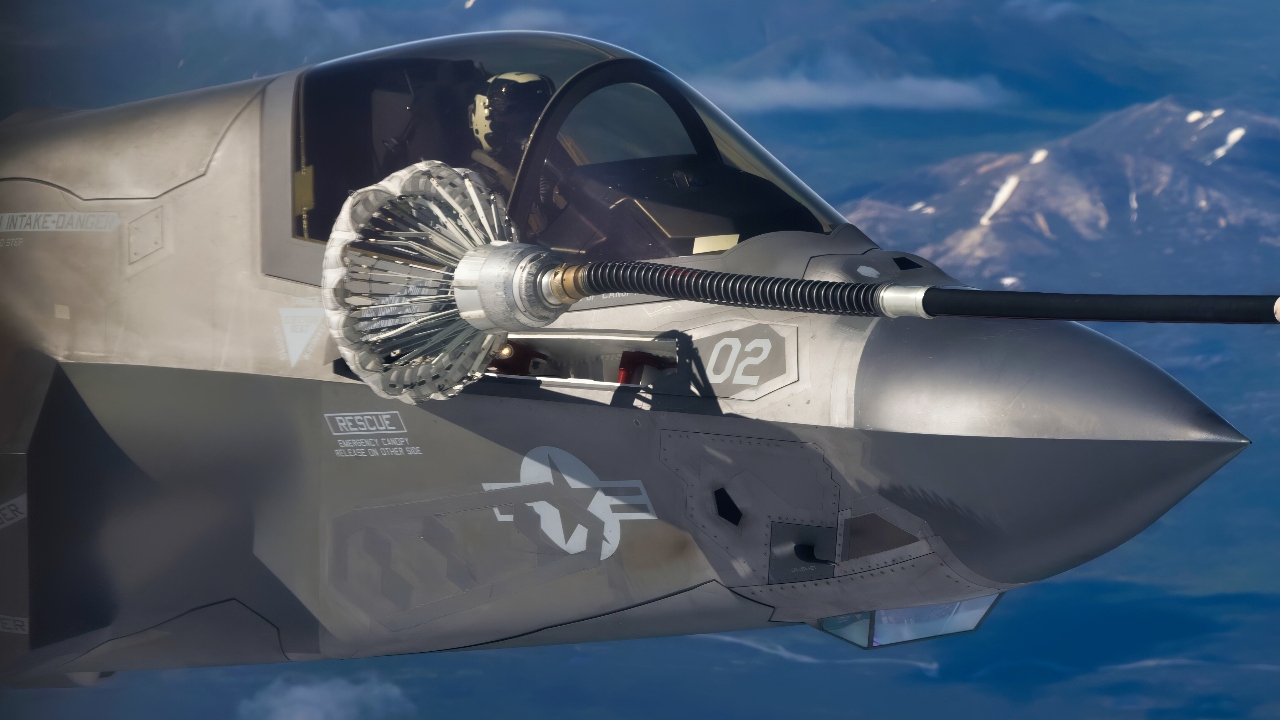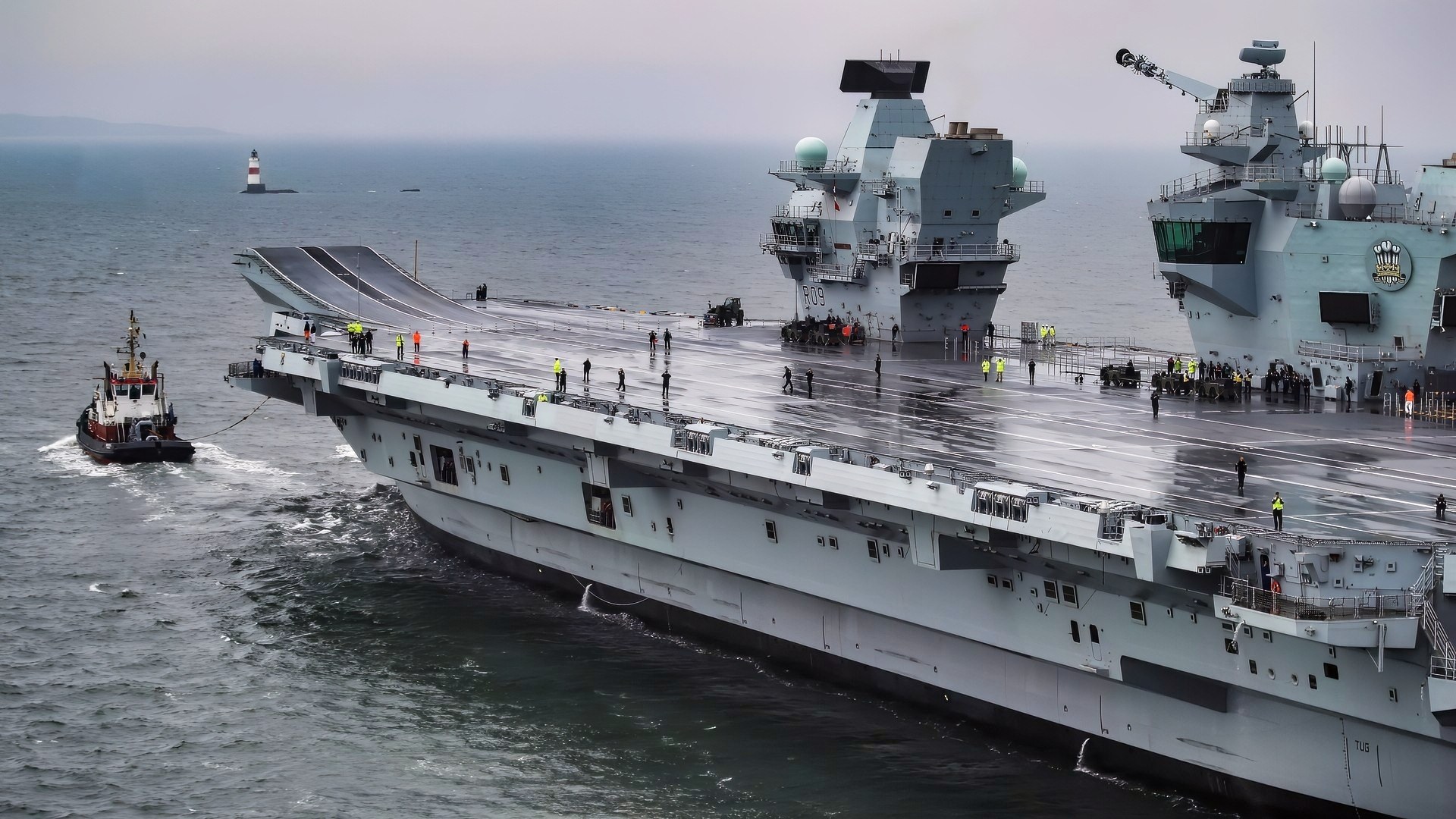Article Summary – HMS Prince of Wales, Britain’s second Queen Elizabeth-class carrier, has shaken off floods, propulsion failures and years of repairs to emerge as the Royal Navy’s flagship.
-Now operating F-35Bs, Merlins and drones on global cruises from Norway to Australia and the Med, the ship is finally delivering the NATO reach London promised.

F-35 test pilot Marine Maj. Paul Gucwa from Air Test and Evaluation Squadron Two Three (VX-23), Naval Air Warfare Center Aircraft Division (NAWCAD), flies an F-35B Lightning II fighter aircraft to the U.K. HMS Prince of Wales aircraft carrier in the Western Atlantic Oct. 11, 2023. Image Credit: Creative Commons.
-Critics say she’s too vulnerable and too expensive to keep, but recent deployments show the carrier giving the UK genuine strike, ASW and alliance value that would be impossible to replace if she were retired early, especially in any future crisis with Russia.
From Embarrassing Breakdowns to NATO Flagship: HMS Prince of Wales’ Comeback
The HMS Prince of Wales (R09) aircraft carrier has a message for the British Royal Navy. It will not go away for the next several decades, even though it has endured some difficulty during its short history. The Prince of Wales is one of the biggest and most impressive vessels ever built for the Royal Navy. It is the second carrier of the Queen Elizabeth-class.
Portrait of the Prince of Wales
The Prince of Wales features up to 36 F-35B Lightning II stealth aircraft, but usually sails with 24. The jump-jet VSTOL F-35 variant is perfect for the Prince of Wales, enabling regular launch of a valuable radar-evading air superiority and ground-strike fighter.

250520-N-TW227-1112 EAST CHINA SEA (May 20, 2025) An F-35B Lightning II fighter aircraft from Marine Fighter Attack Squadron (VMFA) 242, prepares to land on the flight deck of the forward-deployed amphibious assault ship USS America (LHA 6) while conducting flight operations in the East China Sea, May 20. America, lead ship of the America Amphibious Ready Group, is operating in the U.S. 7th Fleet area of operations. U.S. 7th Fleet is the U.S. Navy’s largest forward-deployed numbered fleet, and routinely interacts and operates with allies and partners in preserving a free and open Indo-Pacific region. (U.S. Navy photo by Mass Communication Specialist 3rd Class Kenneth Melseth)
The Prince of Wales can also use its four Merlin helicopters to deploy elite Royal Marines for special operations missions. It can cover 500 miles in a single day while on patrol. Its fighters can conduct air policing sorties to protect the fleet or provide early warning of encroaching enemy aircraft. There are also reconnaissance drones and anti-submarine aircraft.
The carrier is 230 feet wide and 918 feet long. It has a 45-day endurance before replenishment. There are 1,600 sailors on board.
Undergoing a Successful Cruise
On November 1, the HMS Prince of Wales made a port call in Crete, Greece, as part of a carrier strike group mission called Operation Highmast. This long-range voyage demonstrates the ship’s global reach. The Prince of Wales can continue training operations throughout the Mediterranean and perhaps the Indo-Pacific, so personnel on the flight deck and pilots can gain valuable experience.
The Prince of Wales is being supported by the Type 45 destroyer HMS Dauntless, the Type 23 frigate HMS Richmond, plus escort ships from Canada, Norway, and Spain.
During this deployment, the F-35Bs participated in the Italian-led Exercise Falcon Strike to rehearse NATO interoperability and teamwork.

A U.S. Marine Corps KC-130J Super Hercules aircraft with Marine Aerial Refueler Transport Squadron (VMGR) 152 refuels an F-35B Lightning II aircraft with Marine Fighter Attack Squadron (VMFA) 121, both assigned to Marine Aircraft Group 12, 1st Marine Aircraft Wing, during exercise Red-Flag Alaska 25, at Joint Base Elmendorf-Richardson, Alaska, July 21, 2025. VMGR-152 partnered with the U.S. Air Force during Red Flag Alaska to enhance aerial refueling and assault support capabilities. Training in Alaska’s harsh environment sharpened the squadron’s combat readiness and lethality. (U.S. Marine Corps photo Lance Cpl. Cecilia Campbell)
The Visit to Australia Was Unique in History
The Prince of Wales has been busy this year. “In July, HMS Prince of Wales became the first non-U.S. aircraft carrier to participate in the Australia-hosted multilateral Exercise Talisman Sabre. She also docked in Darwin, marking the first visit of a Royal Navy aircraft carrier to Australia since HMS Illustrious in 1997. In August, a UK F-35B landed on the Japanese aircraft carrier JS Kaga, the first time a British jet has ever landed on a Japanese carrier. In October, British and Indian Carrier Strike Groups conducted joint maritime exercises for the first time in history,” according to Naval News.
The Prince of Wales was first launched in 2017. Sea trials commenced in 2019, and the carrier arrived at its homeport in Portsmouth that year. Early training included F-35Bs operating alongside Apache attack helicopters. The first time these two aircraft flew from a British flight deck.
In Three Letters: Sad
In 2020, there was minor flooding on the Prince of Wales. During October of that year, flooding caused additional water damage to the electrical system. This took eight months of repairs, and a mission to the United States was cancelled.
That year, the carrier was rarely at sea. Testing and evaluation resumed in 2021.
There was a joint exercise that year near Scotland, combining drills with the sister carrier, HMS Queen Elizabeth. In 2022, it served in a NATO exercise as part of a task force with the French navy.
Sea Worthiness Was in Question
More problems ensued that year. “The external coupling that connects the outer propeller shaft to the drive shaft from the propulsion motors had failed,” according to NavyLookOut.com.
The Royal Navy deemed this an “unprecedented” problem. Starboard propulsion was also negatively affected. It was determined that the engineers failed to properly lubricate the shaft.
Repairs on the starboard propeller continued through 2023. By September, the carrier visited the United States to rehearse launching and arresting the F-35Bs.
The weather wasn’t perfect, but this was good training for the British Lightning II pilots. There was also a testing and evaluation period for the Mojave drone.
In 2024, the HMS Prince of Wales was ready to take part in a major NATO exercise, Steadfast Defender, off the coast of Norway with a complete F-35B air group.
It also rehearsed anti-submarine efforts. The Prince of Wales took over the role as the flagship of the British Royal Navy. Later in 2024, it led Exercise Strike Warrior.
In all, HMS Prince of Wales has performed its duties effectively. The mechanical problems were difficult, and the time spent in port for repairs was embarrassing.
But it cracked on and is now an important point of pride for the Royal Navy.
There are some questions about the carrier’s survivability against anti-ship missiles and swarming drones. Some have even called for the Prince of Wales to be retired to save money.
This is a premature judgment, and the British need the two carriers to be in top shape for future NATO operations.
The Prince of Wales is a valuable asset to the British military. Soon, operating F-35Bs will become old hat. NATO is glad the ship is finally cruising successfully to Greece. This is an example of the crew’s global reach and effectiveness.
The British should allow the Prince of Wales to have a long service life, as he could serve in potential strike missions in a hot war with Russia or enforce no-fly zones if there is a peace plan for the war in Ukraine. NATO depends on this carrier to maintain a successful service life and avoid being taken out of action.
About the Author: Brent M. Eastwood
Author of now over 3,000 articles on defense issues, Brent M. Eastwood, PhD is the author of Don’t Turn Your Back On the World: a Conservative Foreign Policy and Humans, Machines, and Data: Future Trends in Warfare plus two other books. Brent was the founder and CEO of a tech firm that predicted world events using artificial intelligence. He served as a legislative fellow for US Senator Tim Scott and advised the senator on defense and foreign policy issues. He has taught at American University, George Washington University, and George Mason University. Brent is a former US Army Infantry officer. He can be followed on X @BMEastwood.
More Military
The YF-23 Black Widow II Stealth Fighter Almost Made the Ultimate Comeback
The New Leopard 2A8 Tank Has a Message for the Russian Army
The F-22J Raptor Stealth Fighter Will Never Fly For Japan (China Is Smiling)










